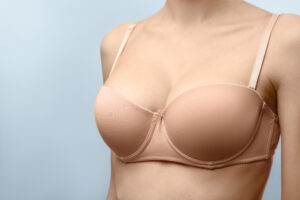 This was a real question today.
This was a real question today.
What is it about?
Sometimes your tissue needs some help. For women who have very thin cover over a breast implant after breast augmentation:
- has had a mastectomy, so there is no breast tissue
- is super skinny, with little to no body fat or breast tissue
- has a bad rib cage alignment, where the ribs slant down and out
- has had prior issues already with implant migration
- are putting in a large implant, which will stress the tissues.
They need a little bit of extra help and support.
In the past, this was a good case for using a textured implant. But with ALCL risk from textured implants, and the higher rate of biofilm associated with texturing, textured breast implants are no longer widely used.
So what can we offer these women to help protect them?
This is where we add another layer to help support their tissue. You may hear of “mesh” or an “internal bra” or “internal support.” What we plastic surgeons are doing in these cases is adding a layer to help support the weight of the implant and take some of the stress off your skin. Think of it as if we are working with tulle fabric. You see people put a liner or backer on tulle, so it has more integrity and strength. In the past, the widely used ADM (acellular dermal matrix) products were Alloderm and Strattice. These are biologic meshes made from animal or human dermis. There are nonbiologic meshes like Seri. The newest mesh on the market is Galaflex.
- Strattice is acellular dermal matrix is a mesh made from animal tissue. “It is a biologic, designed to integrate into, or become part of, the body’s tissue.”
- Alloderm is acellular dermal matrix is a biologic mesh made from cadaver skin.
- Galaflex is made from a “biopolymer” which absorbs over 18-24 months, providing a lattice for new tissue ingrowth. It is estimated to make the native tissue 3-4 times stronger. It purportedly has less inflammatory response when remodeling compared to other soft tissue meshes.
I avoid mesh when I can. It adds extra expense and an extra layer of things that can go wrong. But there are some people who need the extra support. Currently I tend to use Galaflex now for three basic reasons:
- cheaper.
- it is stronger.
- at my national meetings the majority of reconstructive surgeons who used to use ADM and mesh frequently have converted over to Galaflex.
Again, I tend to use it when I need it. But there are cases where it helps. I do not use it in my breast lift and breast reduction patients, as I do the vertical lollipop technique, where I remove that inferior tissue, so mesh is not needed there. Mesh in breast reductions and breast lifts is usually used in the inferior pedicle Wise pattern (anchor scar) technique. The anchor scar technique keeps that lower tissue, so it needs support in the inferior pole much more than the lollipop scar technique. It is part of why I think the lollipop scar technique is better.
The information provided on this website is for general informational purposes only and does not constitute medical advice, diagnosis, or treatment. Always seek the advice of a qualified healthcare provider for any questions regarding your health or medical condition.
